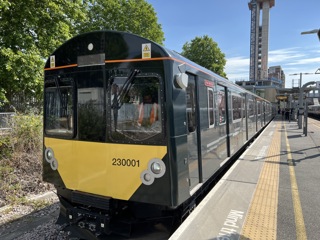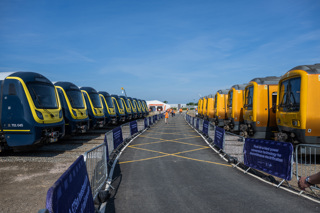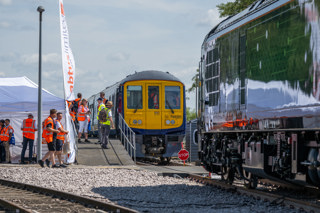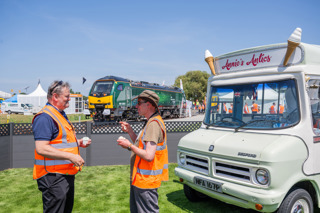Good morning.
This morning I want to address a subject that perhaps isn’t currently receiving the attention it deserves.
And that is the subject of sustainability.
In recent years, we’ve talked a lot about investment, capacity and connectivity.
And rightly so – there’s a huge amount happening in rail under each of those themes.
But I believe our job to revitalise Britain’s railways isn’t finished until have a railway that is not just high-capacity and well-connected, but a railway that is also sustainable.
So I want to set out what I take sustainability to mean in the context of rail, and why it is important.
What is sustainability?
First, then – what is a sustainable railway?
To my mind, the answer is clear.
It’s a railway that is fit for the future.
One that helps solve the environmental challenges we face, rather than contributing to them
It’s a railway that is properly connected to the communities it serve
And it’s a railway that has invested in the workforce it needs for the decades ahead.
A railway meeting environmental challenges
So, first, let me talk about how our railway can best meet the environmental challenges we face.
When I speak to my rail counterparts, from everywhere from Canada to Egypt to Taiwan, they talk about environmental sustainability as the driving reason for their investment in rail.
They see railways as a way of tackling congestion and improving our air quality.
But in this country, talking in those terms is less common.
That’s a real missed opportunity, because there’s so much for us to be proud about.
We are one of the greenest transport modes, and we are getting greener.
Right now we are on target to reduce per-passenger kilometre carbon emissions by 37% between 2014 and 2019.
We need to talk about these successes more.
But our words must be matched with continuing activity.
Trains
Let’s carry on making our new trains ever-lighter and more efficient.
The new class 700 trains for Thameslink, for example, will be 20% lighter than the existing fleet and will use a third less energy.
And I don’t agree with those who say that because some stretches of our rail network are not currently being electrified, we will never have a rail network without diesel trains.
I can see a future in which all-electric trains can run on non-electrified track by switching to battery power.
Last year my department sponsored the trial of a battery powered Class 379 train in Essex.
We demonstrated that battery technology is able to power a train reliably.
Yes, we need the range to improve.
But longer-lasting batteries are the holy grail of industry the world over, so the technology will mature sooner than we expect.
And I am working with colleagues in DECC to see how government investment in battery storage solutions for renewable energy can be applied to improving battery train ranges.
Sustainable stations
Our stations, too, can make their contribution to sustainability.
Take Blackfriars.
It’s a stunning symbol of a modern railway.
But too-few people know that it is also a sustainable structure.
Blackfriars’s roof’s 23 tennis-courts-worth of solar panels provide up to 50% of the station’s energy; enough to heat 80,000 cups of tea a day.
Very few buildings have expanses of roof like our stations do, and they are often perfect for installing solar panels.
Imagine if all our stations used their roofs in this way.
Freight
I believe there’s a real opportunity for rail freight to contribute to sustainability, too.
One of the greatest challenges of our age is the emission of particulate matter from vehicles.
This is not just a problem for future generations or far-away places.
Particulates are here now, on our streets, already shortening lives.
And one of the key contributors is road freight and the need to bring goods from out-of-town distribution centres into city centres.
Yet our rail lines already reach into stations located in the heart of the city.
Imagine if we could run electric freight trains into stations outside peak hours.
Or run passenger trains that can be partly converted to carry freight.
Goods could be offloaded onto electric vehicles, for distribution across the city.
Lets set ourselves the challenge of investing in new freight technology and joined up logistics.
Launch of RSSB Sustainability Principles
These are just a few ideas for creating a railway that meets our environmental challenges, rather than contributing to them.
If we are to achieve our sustainability goals, we need to design them into policies, procurement and operations right from the start.
So today I am delighted to launch the Rail Safety and Standards Board’s Sustainable Development Principles 2016.
The previous edition set the standard for the industry.
We recently started including the principles in franchise competitions, where they have prompted bidders to increase energy efficiency of stations and trains and to reduce waste.
But we want to take these refreshed principles further.
From now on, they will form an important part of all future rail franchises.
And in doing so they should have an effect throughout the whole industry.
Railway connected to communities
Now, the major change to the principles, is that they include an aspiration for rail to have a positive social impact, focussing on engaging with local communities in making plans, and in deciding how local assets are to be used.
And that brings me to my second point.
A sustainable railway is one that is connected to the community it serves.
After all, a railway is not a closed system.
It’s rooted in neighbourhoods, and part of the fabric of local life.
Everyone has a stake in the success of our railways.
And the railway has a stake in so many local communities.
It’s a reciprocal relationship that I want the industry to take seriously.
Station assets used by the community
In many places, it’s already happening.
A once-disused waiting room at Great Malvern Station is now a shop selling craft made by people with learning disabilities.
And I have been really pleased by the way that, under the terms of the Northern franchise, we have agreed that disused railway assets should become community centres.
There are underused railway buildings like this in towns, cities and villages all over the country, and it would be great for more of them to put to use for local benefit.
Community railways
I’m also a big fan of community railways.
Across the county, thousands of volunteers are together giving 250,000 hours a year in support of their local railway lines.
In March we launched a competition for ideas to make it easier for tourists to use heritage and community railways.
These railways reach into parts of the country that tourists often miss.
So last week we held a Dragons’-Den-style pitching event.
We got some great ideas and will be announcing the winners soon.
By putting our railways in the service of local life in these ways, we are gaining support for the railway even from the people who don’t currently use it.
And a widely-supported railway is a sustainable railway.
Sustainability of rail workforce
But my final theme today is about the rail workforce.
I make no apologies for returning to a theme that I know will be familiar to many.
A sustainable railway needs a sustainable workforce.
But, today, parts of the rail industry are set to lose half their staff to retirement within 15 years.
That’s unsustainable, but so too is the idea that we can run a railway with a workforce that looks nothing like the public it serves.
In particular, we need more women working in rail.
Women make up 51% of the population.
47% of the national workforce.
But only 16% of the rail workforce, and a shockingly low 5% of train drivers.
Crossrail has shown what women can do if they are brought into the industry.
Of those who have undertaken work experience on Crossrail, over a fifth are women.
Of those taking part in Crossrail’s graduate programme, many of whom will go on to be the future leaders of the industry, women make up almost a quarter.
And in total, of the 10,000 people working on Crossrail, nearly one third are women.
The result is clear.
Crossrail is on time.
On budget.
We are the proven world-leaders in urban and soft-ground tunnelling.
And there it seems there’s barely a dignitary or minister in Europe who hasn’t donned an orange jacket to marvel at Crossrail’s incredible underground structures.
That’s what a sustainable workforce can achieve.
And it’s a model for the rest of the industry to follow.
Conclusion
And so I hope that will spark some debate.
We need to build a railway that is sustainable.
A railway that works for the people it serves.
And a railway that looks like the people it serves.
Thank you.
(c) GOV.UK website


















Phil Charlton - 19/05/2016 16:04
whilst diesel exhaust particulates are indeed a problem, you are missing a crucial important factor: the amount of particulates coming from the relatively small number of diesel trains running into city centres is vastky overshadowed by the enormous amounts of same coming from HGVs that are clogging the streets of those same cities delivering goods that could and were until reasonably recently delivered by rail, into goods stations or discharge points to be taken from their to destination, rather than loading an HGV and driving it sometimes several hundred miles. Ont HGV wont make a big difference, but how many thousands run the length and breadth of the UK every single day?? Yes we cannot get all of them off the roads, but we could, AND SHOULD do more to get many of them back onto the rails. The RTA is a powerful lobby group, and has ears all over westminster and will refuse to undertake anti pollution measures as it will cost them money iin reduced income and revenues : this needs to change. Government needs to get a grip and mandate a measure of rail transportation that will replace road transport levels. The semi-blinkered drive to electrify the entire network may happen, and indeed battery powered commuter trains might well also, but thats an aspiration and one that is far from becoming anything like viable at this time, or indeed within 15-20 years, if that. I am pleased that someone is looking seriously at the future, but from an experienced railwaymans perspective, these fabulous steps and measures are still taking things to the wrong places and in the wrong directions. I really hope that i do live long enough to see a battery powered 4 or 6 car commuter unit, capable of running 150 miles at 100 mph or a freight loco capable of hauling 1500 or 2000t trains at 75 mph, but I seriously doubt it.